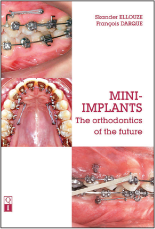Translate this page into:
Mini-Implants. The orthodontics of the future
This article was originally published by Wolters Kluwer and was migrated to Scientific Scholar after the change of Publisher.

Author: Skander Ellouze, François Darque
Publisher: Quintescence
Year: 2014
Pages: 260
ISBN: 978-2-36615-018-6
Edition: 1st Ed
Dr. Skander Ellouze (DDS-MS-PHD) runs a private practice in Tunis (Tunisia) that specializes in the use of advanced technologies such as passive self-ligation, lingual orthodontic and clear aligners, and the use of cutting edge technologies such as computed tomography scan, and other digital imaging to produce aesthetic and efficient customized solutions for his patients. Dr. Ellouze is recognized as a leader in the field of Lingual orthodontics, passive self-ligation and skeletal anchorage systems (temporary anchorage devices). Dr. Ellouze has written several articles, and his recently published a book titled: Mini-Implants: Orthodontics for the future, lives up to his excellent reputation of being cutting edge in orthodontics.
Orthodontists operate in an environment of constant movement. Their aim is to shift the balance within the orofacial complex and achieve more functional and esthetic outcomes. They adjust orthodontic movements by attempting to control the dimension and direction of the natural and prosthetic forces involved. In so doing, they identify points with reduced mobility (i.e., points of anchorage) that they can use for support to guide the forces in the predetermined direction. Because fixed points in space are inconceivable, it is preferable to think of anchorage in terms of mobility or differential stability. Various points of anchorage have been devised outside the oral cavity (e.g., Arms on the Macary expander, the cranial vault for Angle and Tweed, and the cervical region for Kloehn) and intraorally (e.g., Tweed’s anchorage preparation, Kyung’s alveolar anchorage, and De Clerck’s skeletal anchorage).
Mini-implants offer a useful anchorage solution in as far as they:
Are relatively simple to place.
Preclude the need for cooperation from patients fitted with extra- or intra-oral appliances.
Are increasingly reliable, thanks to technologic advances, including in placement techniques.
The use of mini-implants has now become everyday practice, but the biomechanics of their mode of action has not yet been fully understood by all orthodontists. The author’s long-term users of mini-implants analyze and explain the feature underpinning, the way they work and how they can best be used.
Using orthodontic biomechanical principles the most common clinical situation are explored and illustrated with numerous examples (distalization of maxillary or mandibular molars, molar protractaction, intrusions, asymmetry management, control of the vertical dimension, expansion, multidisciplinary treatment). In the wide range of the clinical situation, mini-implants are used in association with the most recent leading-edge orthodontic innovations (self-ligating mechanics, lingual technique, etc.).
Understanding of the biomechanical applications of mini-screw — supported anchorage is constantly developing and needs to be expanded further if we are to improve the efficacy of these devices. Alveolar anchorage allows orthodontists to obtain movements that were difficult or even impossible to achieve previously (e.g., for vertical asymmetries, frontal rotation of the dental arches, or molar extrusion following the loss of antagonist teeth).
In addition to these “occasional” indications, several authors have sought to devise precise therapeutic protocols for using mini-implants in the treatment of classical Angle malocclusions.
Modern day orthodontics can no longer afford to neglect these particularly effective and comfortable anchorage devices, which have extended indications to clinical situations where practitioner previously ran up against technical difficulties or problems of patient discomfort.
With this volume, Skander Ellouze and Francois Darque have provided one of the greatest and most comprehensive contributions to this clinical research endeavor, representing a great stride forward in orthodontics.
The key ideas of the book are that it is not organized by malocclusions but essentially by type of movements because the same movement can be indicated for the treatment of different malocclusions. The focus areas of the book are:
PART I
-
Chapter 1:
Choosing the mini-implant.
-
Chapter 2:
Mini-implant placing techniques.
-
Chapter 3:
The biomechanics of mini-implants.
PART II
-
Chapter 4:
Maxillary molar distalization.
-
Chapter 5:
Mandibular molar distalization.
-
Chapter 6:
Molar protraction.
-
Chapter 7:
Orthodontic management of arch asymmetries using mini-implants.
-
Chapter 8:
Molar vertical control in hyperdivergent patient and in skeletal open bites.
-
Chapter 9:
Mini-implants assisted expansion.
-
Chapter 10:
Management of mini-implant supported multidisciplinary treatments.





